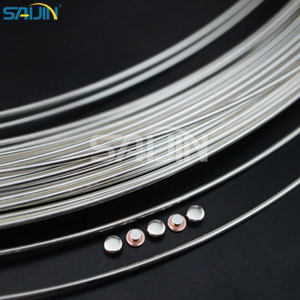Characteristics and uses of white copper (AgNi)
White copper, also known as nickel silver (AgNi), is an important branch of copper-based alloys. It is famous for its unique silver-white luster, excellent comprehensive performance and wide application fields. As an important variety of white copper, nickel silver not only carries profound historical and cultural value, but also radiates new vitality in the field of modern industry and technology.

1. Characteristics of white copper: the perfect combination of art and technology
The core components of white copper are copper, nickel and zinc. The typical BZn15-20 alloy contains 15% nickel, 20% zinc, and the balance is copper. This ratio gives the material multiple advantages:
Excellent mechanical properties: white copper has both high strength and good ductility, and can withstand the test of complex processing technology.
Excellent process performance: easy to cast, forge and cold and hot processing, suitable for making precision devices and complex crafts.
Unique silver-white luster: The surface presents a silver-like cold white tone, and has strong oxidation resistance. It is not easy to change color after long-term use. It is known as a model of "imitation silver art alloy".
These characteristics make it an ideal material for artistic creation. As early as the Song Dynasty, Chinese craftsmen used white copper to create exquisite handicrafts known as "Chinese Silver", and their craftsmanship level had reached the world's leading position at that time.
2. The leap from traditional crafts to modern industry
Historically, white copper has been widely used in the production of currency, decorations and religious objects due to its silver-like properties. For example, although the gilded silverware of the Song Dynasty was named after silver, it was actually replaced by white copper, which not only reduced costs but also maintained artistic expression.With the industrial revolution and technological progress, the application scenarios of white copper have undergone a qualitative leap:
Electronic communication field: As a key conductive material, white copper is used to manufacture precision plug-ins, AgNi Alloy Wires and relay components. Its stable conductivity and corrosion resistance ensure the reliability of long-term operation of the equipment.
Electromagnetic shielding technology: Modern electronic equipment widely use nickel white copper (a high-nickel white copper) as an electromagnetic shielding shell to effectively block electromagnetic interference.
Precision instrument manufacturing: In the fields of medical equipment, optical instruments, etc., white copper has become the preferred material for high-end equipment due to its non-magnetic and biocompatibility.
3. Future Outlook: Diversified Development Driven by Innovation
At present, the research and development of nickel white copper is extending towards functionalization and environmental protection. For example, by adjusting the ratio of nickel and zinc or adding rare earth elements, its high temperature resistance can be further improved; in the field of new energy, the application research of nickel white copper battery connectors is also continuing to advance. At the same time, breakthroughs in recycling technology will help this traditional material achieve green and sustainable development.
Conclusion
From the "Chinese Silver" thousands of years ago to today's "Technology Silver", the evolution of nickel white copper reflects the profound understanding and innovative spirit of human beings in materials science. This alloy that combines artistic aesthetics and industrial practicality will continue to write a new chapter in the interweaving of traditional craftsmanship and modern technological innovation.




